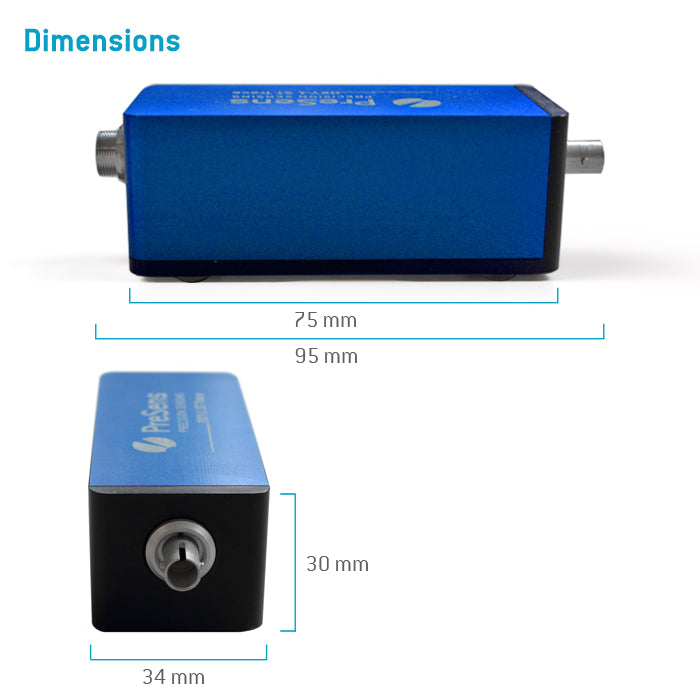





The OXY-1 ST is a compact oxygen meter that can be used with PreSens optical oxygen flow-through sensors or SensorPlugs. It offers temperature, pressure, and salinity compensation for more precise measurements of oxygen levels. This meter is USB-powered and can be operated with the PreSens Measurement Studio 2 software.
General
This single-channel oxygen meter is small and lightweight for easy integration in many applications. It is compatible with optical sensor type PSt7 (detection limit 15 ppb) with a measurement range of 0-100% oxygen. This includes oxygen microsensors in different designs such as flow-through sensors and SensorPlugs from PreSens.
The OXY-1 ST meter offers temperature, pressure, and salinity-compensated measurements. It is USB-powered and is operated with the PreSens Measurement Studio 2 software, which can control several devices simultaneously.
The complete setup for PreSens technology includes a meter, a sensor, and relevant accessories including the optic fiber. These components can easily be integrated to any microfluidics and organ-on-chip experiments.

Optical oxygen sensors offer several advantages that render them particularly well-suited for controlling small sample volumes:
- They are small
- The signal does not depend on the flow rate of the sample
- They allow for non-invasive measurement
Content
1x Compact optical oxygen meter OXY-1 ST
1x USB cable
Specifications
| Oxygen sensor | PSt7 |
| Optical connector | ST |
| Temperature sensor | Pt100 temperature connector (sensor not included)* |
| Power supply | 5 VDC (USB-2.0-Mini-B, cable included) |
| Current | 400 mA |
| Operating temperature | from 0°C to +50°C |
| Storage temperature | from -20°C to +70°C |
| Relative humidity | 0% to 80% (non-condensing) |
| Dimensions | 99 mm (with connectors) x 35 mm x 30 mm |
| Weight | 128 g |
| Digital Interface | USB interface cable to PC |
* All systems can be used without a temperature sensor as the temperature value used for temperature compensation can be set manually in the respective device software. Therefore, the measurement temperature has to be known and remain constant throughout the measurement to ensure correct temperature compensation.

Documentation
The OXY-1 ST is a compact oxygen meter that can be used with PreSens optical oxygen flow-through sensors or SensorPlugs. It offers temperature, pressure, and salinity compensation for more precise measurements of oxygen levels. This meter is USB-powered and can be operated with the PreSens Measurement Studio 2 software.
General
This single-channel oxygen meter is small and lightweight for easy integration in many applications. It is compatible with optical sensor type PSt7 (detection limit 15 ppb) with a measurement range of 0-100% oxygen. This includes oxygen microsensors in different designs such as flow-through sensors and SensorPlugs from PreSens.
The OXY-1 ST meter offers temperature, pressure, and salinity-compensated measurements. It is USB-powered and is operated with the PreSens Measurement Studio 2 software, which can control several devices simultaneously.
The complete setup for PreSens technology includes a meter, a sensor, and relevant accessories including the optic fiber. These components can easily be integrated to any microfluidics and organ-on-chip experiments.

Optical oxygen sensors offer several advantages that render them particularly well-suited for controlling small sample volumes:
- They are small
- The signal does not depend on the flow rate of the sample
- They allow for non-invasive measurement
Content
1x Compact optical oxygen meter OXY-1 ST
1x USB cable
Specifications
| Oxygen sensor | PSt7 |
| Optical connector | ST |
| Temperature sensor | Pt100 temperature connector (sensor not included)* |
| Power supply | 5 VDC (USB-2.0-Mini-B, cable included) |
| Current | 400 mA |
| Operating temperature | from 0°C to +50°C |
| Storage temperature | from -20°C to +70°C |
| Relative humidity | 0% to 80% (non-condensing) |
| Dimensions | 99 mm (with connectors) x 35 mm x 30 mm |
| Weight | 128 g |
| Digital Interface | USB interface cable to PC |
* All systems can be used without a temperature sensor as the temperature value used for temperature compensation can be set manually in the respective device software. Therefore, the measurement temperature has to be known and remain constant throughout the measurement to ensure correct temperature compensation.

